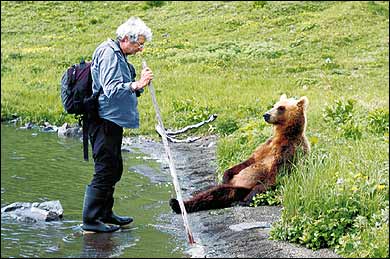FOR DARING TO WORK closely with bears, Timothy Treadwell was called a fool. I have also worked closely with bears and been called a fool for it.
For seven summers, from 1996 to 2002, I lived with my partner, Maureen Enns, in a cabin on Russia’s remote Kamchatka Peninsula, home to one of the densest populations of brown bears in the world. Our goal was to prove that peaceful coexistence with bears is possible. To do this, we had to know if they were unpredictable, ready to turn on humans at the drop of a hat. This isn’t something you can learn by looking through a spotting scope. We spent hundreds of hours only a jump away from dozens of wild bears, often with our backs turned to them. Many people predicted that we would end up dead.
Like Timothy, we were pioneers, trying to understand bears by getting to know them. Like Timothy, we took risks that were nonsensical, dramatically stating our closeness to counter the exaggerated depictions of ferocious bears in hunting magazines.
From our time in Kamchatka, Maureen and I learned that bears have a tremendous capacity to get along with humans. Elephants, gorillas, and killer whales have all benefited greatly from studies showing the reliability of their behavior. Where we used to machine-gun killer whales to protect harbors, we now kayak among them. This same progression is possible with bears. I’m not saying we can live cheek to jowl with bears everywhere, but we don’t have to keep them universally away from people.
I first met Timothy in 1995, at a bear conference in Bozeman, Montana, and we spoke by phone at the end of every season we spent working with bears. When he and Amie Huguenard were killed, I traveled to Alaska to learn as much as I could. I left convinced that he fully understood the dangers. Timothy felt he needed to mock people’s fears about bears in order to disprove them. He didn’t carry pepper spray; he often camped in the bush, without an electric fence, near or on a bear trail. This didn’t make sense to me—I’ve always used both—but it made sense to him. The unfortunate result is that his work was cut short.
My work has also been cut short. Last spring, poachers slaughtered the bears near our Kamchatka cabin—most likely to sell their gallbladders on the black market. But even with these two tragedies, I’m confident that a more complete understanding of bears is gaining momentum. Over the last 14 years, Timothy spent some 36,000 hours with the brown bears at Katmai before one unusually motivated animal happened along. Timothy proved, like we have, that there’s a lot more room for bears in our world.
Counterattack
Famed naturalist Charlie Russell argues that Timothy Treadwell's work was both crucial and sane

(Photo: Maureen Enns)
New perk: Easily find new routes and hidden gems, upcoming running events, and more near you. Your weekly Local Running Newsletter has everything you need to lace up! .
From ���ϳԹ��� Magazine, Jan 2004
Lead Photo: Maureen Enns
